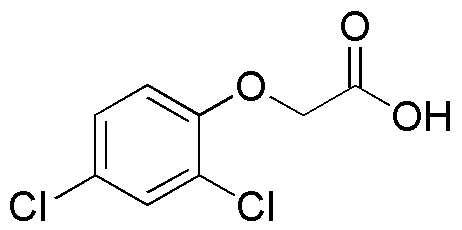2,4-Dichlorophenoxyacetic acid is widely utilized in research focused on:
- Agriculture: This compound is a key ingredient in many herbicides, effectively controlling broadleaf weeds in crops like cereals and pastures, thus enhancing agricultural productivity.
- Plant Growth Regulation: It is used to manipulate plant growth patterns, promoting desirable traits in horticulture, such as improved flowering and fruiting in various ornamental plants.
- Environmental Research: Researchers use it to study its effects on ecosystems, particularly in assessing the impact of herbicides on non-target species and soil health.
- Pharmaceutical Development: The compound serves as a model in drug formulation studies, helping scientists understand the interactions of similar compounds in biological systems.
- Analytical Chemistry: It is utilized in developing analytical methods for detecting and quantifying herbicides in environmental samples, ensuring compliance with safety regulations.
General Information
Properties
Safety and Regulations
Applications
2,4-Dichlorophenoxyacetic acid is widely utilized in research focused on:
- Agriculture: This compound is a key ingredient in many herbicides, effectively controlling broadleaf weeds in crops like cereals and pastures, thus enhancing agricultural productivity.
- Plant Growth Regulation: It is used to manipulate plant growth patterns, promoting desirable traits in horticulture, such as improved flowering and fruiting in various ornamental plants.
- Environmental Research: Researchers use it to study its effects on ecosystems, particularly in assessing the impact of herbicides on non-target species and soil health.
- Pharmaceutical Development: The compound serves as a model in drug formulation studies, helping scientists understand the interactions of similar compounds in biological systems.
- Analytical Chemistry: It is utilized in developing analytical methods for detecting and quantifying herbicides in environmental samples, ensuring compliance with safety regulations.
Documents
Safety Data Sheets (SDS)
The SDS provides comprehensive safety information on handling, storage, and disposal of the product.
Product Specification (PS)
The PS provides a comprehensive breakdown of the product’s properties, including chemical composition, physical state, purity, and storage requirements. It also details acceptable quality ranges and the product's intended applications.
Certificates of Analysis (COA)
Search for Certificates of Analysis (COA) by entering the products Lot Number. Lot and Batch Numbers can be found on a product’s label following the words ‘Lot’ or ‘Batch’.
*Catalog Number
*Lot Number
Certificates Of Origin (COO)
This COO confirms the country where the product was manufactured, and also details the materials and components used in it and whether it is derived from natural, synthetic, or other specific sources. This certificate may be required for customs, trade, and regulatory compliance.
*Catalog Number
*Lot Number
Safety Data Sheets (SDS)
The SDS provides comprehensive safety information on handling, storage, and disposal of the product.
DownloadProduct Specification (PS)
The PS provides a comprehensive breakdown of the product’s properties, including chemical composition, physical state, purity, and storage requirements. It also details acceptable quality ranges and the product's intended applications.
DownloadCertificates of Analysis (COA)
Search for Certificates of Analysis (COA) by entering the products Lot Number. Lot and Batch Numbers can be found on a product’s label following the words ‘Lot’ or ‘Batch’.
*Catalog Number
*Lot Number
Certificates Of Origin (COO)
This COO confirms the country where the product was manufactured, and also details the materials and components used in it and whether it is derived from natural, synthetic, or other specific sources. This certificate may be required for customs, trade, and regulatory compliance.


